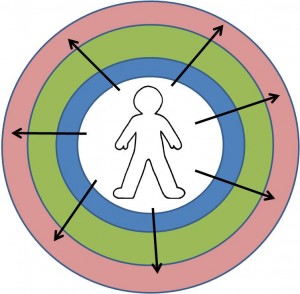
The reasons for employing people are:
1) to do the work (produce output, product, service), and
2) to improve the work.
If the person is clear about the purpose of their work, then 1 and 2 should be easy to deliver if they have the right resources, skills, and understanding of users’ (e.g. customers) needs.
But managers rarely leave it at that…
Traditionally, managers get people to do ‘better’ in their work by what John Seddon tags as ‘sweating the labour’ – getting the people to work harder or faster. The idea is that you get more output for the same hours work – essentially more for the cost (efficiency).
Of course the idea of the sweatshop is morally uncomfortable – exploitation to achieve a profit motive. Yet we still stick to the idea by setting targets: ‘You produced 100 widgets last month, let’s have you aim for 110 widgets this month‘.
It seems plausible – motivational even! What possibly could be the harm in setting a target?
Well, the widgets are being created for a purpose – presumably the purpose for which the customer buys them. And that purpose is associated with the design and quality if production in the widget that is produced.
If you create arbitrary targets (and measures of performance) you will create a de facto purpose in people’s mind which is to deliver those targets. This is different from actually delivering the purpose of the work.
Your worker will work to produce 110 widgets BUT not necessarily a widget that meets the customer needs, nor a widget that could be produced faster or at lower cost whilst still meeting the customers needs, other than by cutting corners (lowering quality or increasing risk). The worker is busy but has got his eye off the ball. This produces errors and lowers the quality of work – which will probably have to be redone – at greater cost.
Targets are not motivational. They might make people move, but that is not motivation. A dog that moves is just one looking to avoid the next kick. It is not a motivated, free thinking, creative, proactive animal. Why would we exect people to operate any differently?
Reading
Herzberg, F. (1968) “One more time: how do you motivate employees?”, Harvard Business Review, vol. 46, iss. 1, pp. 53–62
Seddon, J. (2005) Freedom from Command and Control, Vanguard Press, Buckingham, UK.






 Here is an interesting one – Researchers at Erasmus University and Cambridge University identified that middle managers copy their boss’s behaviour if they are working in close/adjacent proximity to that boss. Conversely, if the boss is not in close proximity (e.g. has an office down the corridor), then the middle manager may behave differently to the boss.This includes good and bad behaviour.
Here is an interesting one – Researchers at Erasmus University and Cambridge University identified that middle managers copy their boss’s behaviour if they are working in close/adjacent proximity to that boss. Conversely, if the boss is not in close proximity (e.g. has an office down the corridor), then the middle manager may behave differently to the boss.This includes good and bad behaviour. Picture the scene…a middle aged man digging in his garden, when he hits an object, possibly a root, which slows his spade. Lifting the top 3 inches of turf away, he clears the space to find that the object is an intact, unfired rifle cartridge – complete with bullet. He thinks ‘Hmmm – either an intact live cartridge or a replica, but 3 inches under my lawn‘ and decides to call the police non-emergency helpline to request its secure collection (the nearest police station is over 10 miles away).
Picture the scene…a middle aged man digging in his garden, when he hits an object, possibly a root, which slows his spade. Lifting the top 3 inches of turf away, he clears the space to find that the object is an intact, unfired rifle cartridge – complete with bullet. He thinks ‘Hmmm – either an intact live cartridge or a replica, but 3 inches under my lawn‘ and decides to call the police non-emergency helpline to request its secure collection (the nearest police station is over 10 miles away). Are the same old issues arising in your team?
Are the same old issues arising in your team?

